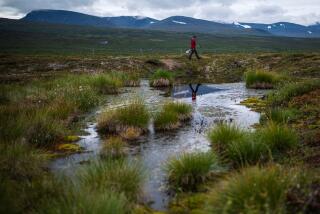Ice Core May Hold Keys to Prehistoric Past and Future : Science: Like the rings in a cross-section of a tree trunk, visible layers and chemical makeup record changes in climate. Some call the ice a time machine.
- Share via
DURHAM, N.H. — Frozen in prehistoric layers of ice, buried deep in the surface of the world’s largest island, is a time machine.
Led by a professor from the University of New Hampshire, teams of scientists are analyzing sections of an ice core extracted through five years of drilling in Greenland.
They hope it may one day tell us what the future holds; but for now, they’re looking at what the ice says about our past.
Paul Mayewski, chief scientist for the project, says the core provides physical evidence that can explain how the Earth’s climate influenced events that shaped human history.
Dynasties and kingdoms fell under devastating weather conditions. The Spanish Armada sank in a churning sea 500 years ago. The American economy was crippled by the Dust Bowl that ravaged the Midwest in the 1920s.
“The Napoleonic wars were affected by the extremely brutal conditions in Russia,” Mayewski said recently in an interview on the University of New Hampshire campus here.
Like the rings in a cross-section of tree trunk, visible layers in the ice record the passing of years. The chemical makeup of those layers--including sulfate, nitrate, methane, carbon dioxide and other atmospheric components--varied with climate changes in the past.
“Ice is like a book, and each year is a page,” said John Kelley, director of the Polar Ice Coring Office of the University of Alaska Fairbanks. “We now know it will be relatively easy to explore the bottom of glaciers. It’s a whole new window on science.”
On the wall outside Mayewski’s office, a graph indicates the levels of various elements in ice formed at different times. Spikes in the ammonia graph show major forest fires. High levels of sulfur mark historic volcanoes.
“This is the kind of view of the world that people have needed,” Mayewski said. “We’ve created a time machine.”
Eventually, the ice--which is 250,000 years old--will produce at least 90,000 years of climate records that will be compared with another core being drilled 19 miles away by a European group, he said. Layers become hard to read in the remaining 160,000 years, which are crammed into 10% of the core, Mayewski said.
Once scientists are able to determine what the Earth’s climate was like without human influence, Mayewski said human contributions--such as the dumping of nuclear waste, car emissions and countless other factors--can be factored in mathematically to project future climatic conditions.
“We have to understand the future,” Mayewski said. “A lot of people think that humans are so intelligent that we can create problems and then solve them.”
Mayewski isn’t so sure. “We can definitely create them,” he said, but solutions are less likely.
Charles Bentley, a glacier expert with the University of Wisconsin-Madison, said the evidence of dramatic climatic change in Greenland is exciting. What remains to be seen, he said, is how representative the changes are of those in other parts of the world.
That can be determined by correlating the core with ones drilled in other parts of the world, he said, particularly if a high-resolution core is drilled at the opposite pole, in Antarctica.
Bentley favors “taking the least astonishing solution first,” namely, that the Greenland core reflects only climate changes in Greenland. But, he said, “I wouldn’t bet on it.”
The National Science Foundation has provided $20 million for the project over five years. Twenty-one research institutions, most of them universities, have participated.
The Air National Guard has transported the 3 million pounds of equipment, and the University of Alaska Fairbanks has done the actual drilling.
The ice is divided into cylinders 3.3 feet long, 5.2 inches in diameter. The cylinders are stored in a refrigerated trailer in a parking lot at UNH.
Mayewski and colleague Cameron Wake examine the ice on an illuminated box; they use plastic gloves to avoid contamination.
Some scientists hope to take prehistoric bacteria from the ice to analyze its DNA, or genetic makeup, Mayewski said.
By drilling at sites in Asia, notably Nepal and southern Tibet, Mayewski said the group hopes to link glacial records that will, through the cross-link of monsoon and jet stream patterns, provide a record encompassing the entire globe.
“We will, I think, have the data we need . . . to understand how climate changes,” he said.
But Mayewski estimated it will take 15 years to get those kinds of records; interpreting them will take still longer.
“We’ll be working on this for the rest of our lives. There’s no doubt about it,” he said.






